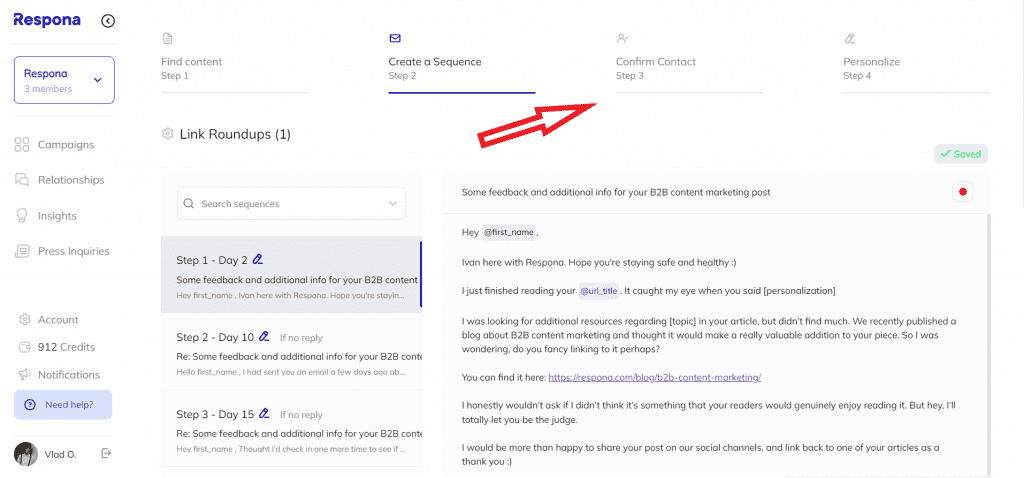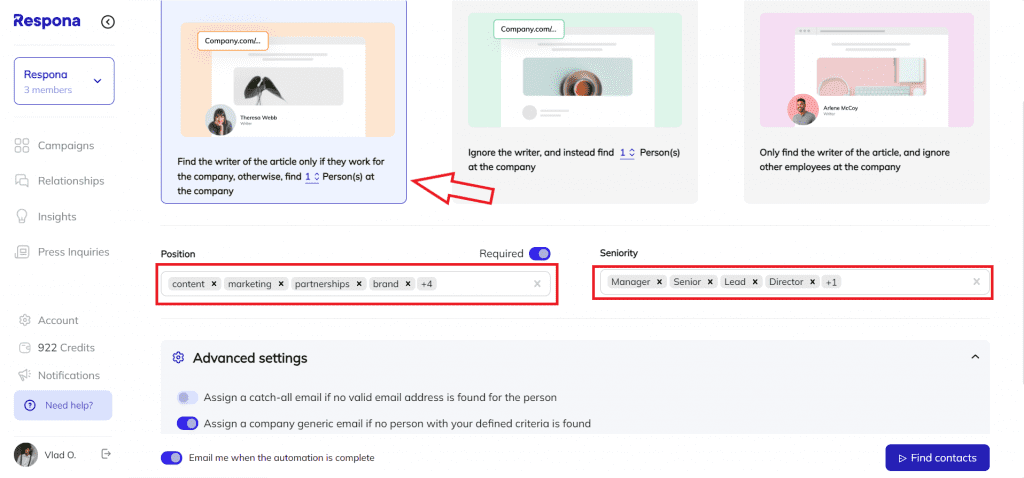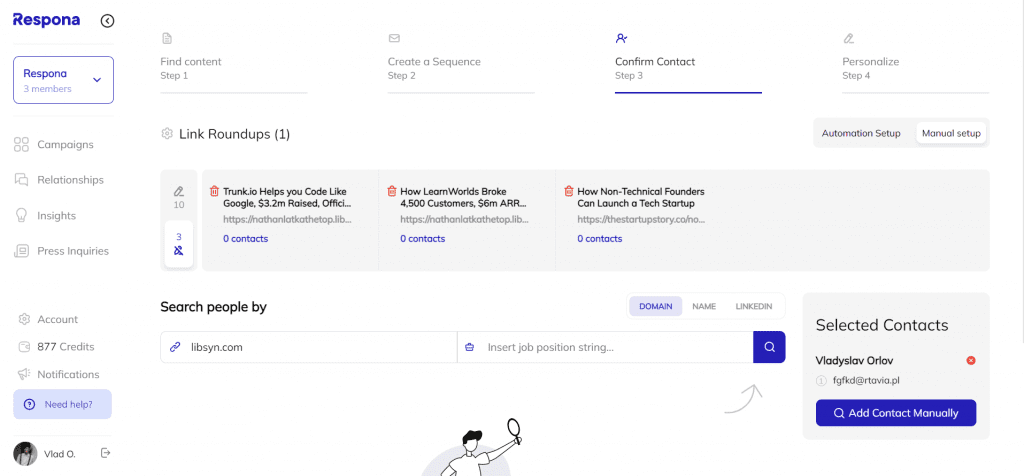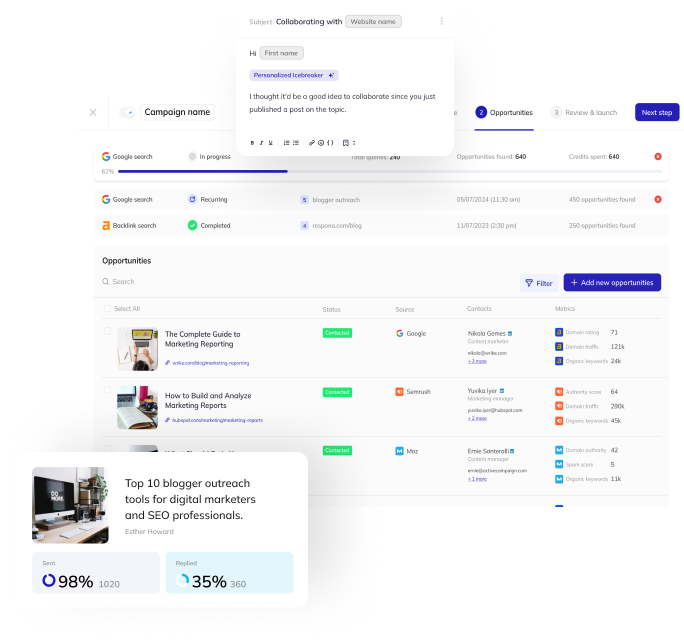We’ve created a guide for beginners at link prospecting.
This guide will help you identify the best prospects for your link building campaigns.
At the beginning, we’re going to explain what link prospecting is and why it’s important.
Then, we’re going to present a simple five-step process professional link builders use when it comes to link prospecting.
Last. but not least, we’re going to give answers to some of the most frequent questions people have when it comes to link prospecting.
We’ve got a lot to cover so let’s get started.
Link building cheat sheet
What is Link Prospecting and Why is it Important?
The first thing we’ll be talking about in this guide on link prospecting is what link prospecting actually is and why it’s important.
To begin with, let’s try to share a clear definition of link building.
Link building is the process of trying to acquire dofollow backlinks – i.e., links from other websites back to your own website – from relevant and trusted domains, AKA referring domains, using ethical tactics that are aligned with Google’s Webmaster Guidelines.
Below, you can see a screenshot where we’ve highlighted some of the tactics that are considered to be against the guidelines of Google and other prominent search engines when it comes to link building.

We would say that in every successful white hat link building campaign, there are three main parts:
- Prospecting
- Qualification
- Outreach
Let’s try to explain what each of the three parts of the process represent.
1) Prospecting
Prospecting is the process of finding link prospects, or link targets, for your link building campaign.
To perform link prospecting, you need to establish the link building techniques you’re going to use as well choose the link prospecting tools that can help you based on the selected techniques.
2) Qualification
Qualification is the process of qualifying the list of prospects, that is link building opportunities, you’ve created based on specific, qualitative criteria.
When we say “qualitative criteria”, we mean metrics like the website’s Domain Authority (DA) as defined by Moz or Ahrefs, total organic traffic, or number of outgoing links.
There are other qualifying criteria such as topical relevance which are not always so obvious and can’t be measured as easily as the website’s DA.
3) Outreach
Outreach is the process of reaching out to your prospects through highly-personalized email campaigns.
The way you perform outreach changes based on your approach to link building.
For example, reaching out to prospective link targets for guest blogging, to publish a guest post on another website for example, is going to be different than reaching out to link prospects to pitch an infographic that you’ve created or to ask for a replacement of a broken link on your prospect’s website, or for a reverse image search link building strategy.
Even though in this guide we’re going to present a process that covers all three aspects of the link building process, we’re mainly focusing on the first step of link building; the prospecting process.
The reason why prospecting is so important is because — to a certain extent — it defines the success of your campaign as a whole.
If you haven’t managed to find high-quality and relevant sites, or link prospects, to reach out to, then chances are that you won’t manage to acquire as many new links.
Thus, link prospecting is not only the first step in the link building process, it’s also one of the most important and time-consuming ones.
Now that we’ve explained what link prospecting is and why it’s important, let’s move on to our five-step process for effective link prospecting.
Five-Step Process for Effective Link Prospecting
In this section, we’re going to be presenting a step-by-step process for effective link prospecting.
As mentioned at the beginning of this guide, we’re going to be discussing all the steps involved in creating and launching a successful link building campaign, with an extra focus on link prospecting.
For this reason, we’re going to be using the following hypothetical scenario:
Respona’s interested in improving the backlink profile – build high quality links – for the following blog post:
https://respona.com/blog/content-distribution/
Thus, we’re interested in finding websites that are relevant to the topic and pitch them our resource.
Let’s begin.
Step #1: Define the Tactic You’re Going to Use and Set Your Evaluation Criteria
The first step in the process is to define the tactic we’re going to use to acquire the best links possible for our resource.
Is it going to be through guest posting? By trying to get into resource pages? Or simply by pitching the resource to relevant websites and bloggers?
In our example, we’re going with the third way:
We’ll try to find pages that discuss the topic of content distribution and pitch them our resource.
Let’s see how that works.
Step #2: Create a List of Link Prospects
After defining the tactics we’re going to use to build links back to the page that we mentioned earlier, we can start working on our link building campaign and implementing the first steps of the process, which – as we’ve covered – is link prospecting.
We’ll do that with the help of Respona.
To begin with, we’ll have to create a new Campaign.

We’re going to have to give a proper name to our campaign that’s easy to identify, especially considering the fact that we’re running multiple campaigns for link building and other purposes.

Author’s Note: If you’re using Respona for building and managing campaigns for your clients, it’s highly recommended to add the brand name of each client as part of the Campaign Name to make sure that you keep track of everything.
Moving on, we have to adjust some Advanced Settings, such as tracking settings such as if we want to add recipients in CC, or to get warnings within Respona when a link prospect exists in another campaign that we’ve run.
This is particularly useful when we’re managing multiple campaigns, either for our own website or for clients.
Last but not least, we have to define a Strategy for our campaign and, as you can see, our selected one is the No-reply strategy.

When we’re done with the naming of our campaign and the settings that we discussed just now, we can click on Continue to start searching for prospects for our link building campaign.
Here’s where things get interesting.
At this point, what we see is a built-in search engine where we can add search queries and advanced search operators to hunt for link prospects or for other outreach purposes, such as blogger outreach and content marketing promotion.
The first thing that we need to do to start setting up Respona’s search engine is to select a Source.

Author’s Note: Keep in mind that Respona’s search results are powered by Bing, so the results you’ll see within Respona may be a little different than the ones that you see in Google search results.
This is particularly important because it allows us to choose the source that Respona will use to give us the best results based on the scope of the campaign.
The sources you’ll find within Respona are:
- Blogs
- News
- Podcasts
- Web Search
In our case, we don’t want to limit the results to any of these sources and, thus we’re going to select Web Search as our source.
Next, we have to insert our search operator.
Our logic here is the following:
We’re searching for blog posts that include the term “content distribution” somewhere in the body and, at the same time, have the term “content marketing” in their title.
This way, we’ll find opportunities that are blog posts which focus on content marketing and mention content distribution as part of a successful content marketing strategy.
Our advanced search operator will be the following:
inurl:blog intext:”content distribution” intitle:”content marketing”

Author’s Note: Respona is integrated with Google, so you can use all of Google’s advanced search operators.
After clicking Enter, we can see that Respona has returned almost 80,000 results based on our search operator.
The button we’ve highlighted allows us to import CSV files into Respona.
In other words, if you happen to already have a list of URLs or opportunities from manual searching, you can upload your file into Respona and use these opportunities in your campaign.

At this point, right after we’ve conducted the search, we have to start selecting our link prospects.
You can do that simply by clicking on the little checkbox that sits on the left of each opportunity.
Alternatively, you can click on the checkbox at the beginning of the list on every page to select all the opportunities on that page.

However, even though it may be a bit more time-consuming, we recommend that you handpick all the opportunities you’re going to reach out to.
This way, you can be sure about the relevance of these opportunities.
In general, we recommend that you add as many relevant and high-authority opportunities as possible to your list of link prospects so that you increase the number of replies you’re going to get.
Once we’ve selected all the opportunities we consider to be relevant, we click on Step 2.

From there, we have to create our email sequence based on the needs and scope of our campaign.
Let’s see how we can do that.
Step #3: Create your Email Sequence
The next step is to create our email sequence.
This actually goes off-piste from the topic of link prospecting.
But, as discussed earlier, we’re going to present the process end to end so that you can understand what’s really involved when it comes to setting up your link building campaign.
The first thing that we need to do is choose whether we want to create a new template or use one of Respona’s predefined templates.

Here’s how things will look like after we’re done creating our email sequence.
Each email has a title that’s relevant, as well as an overview of the email and the day that the email is going to be sent.
In our example, the first email we’re going to send looks like this:
Subject: Regarding your (topic) post
Hey {first name},
Happy {day_of_week}! Just finished reading through your post, {url_title}. It was such a good read, I had to share some thoughts.
Firstly, it really stuck with me when you pointed out that [article summary snippet].
Secondly, you covered, “[anchor/targeted keyword]” in the article, but didn’t go into further detail or link to another resource.
We just released a guide that will provide a little something extra for readers who want to learn more about [anchor/targeted Keyword].
Want to take a look? I got you: [article URL]
As a huge “thank you”, I’d be happy to provide [incentive – (social share, indirect link, free trial, etc)].
Regardless, I’ll definitely be a frequent reader. Keep it up with the stellar content :)
Thanks,
[Your name]
We’ll have to make adjustments to the email body to personalize it and make sure it’s ready to be used in our campaign.
In our template, the {braces} represent pieces of information that’ll be adjusted automatically by Respona, called variables, and the [brackets] represent pieces of information that we have to adjust manually when creating and editing our email sequence.
Besides our first email, we can set up a follow-up email as well, to make sure that our initial email won’t go unanswered.

In general, you can set up as many follow-up emails as you want, but we’d recommend being respectful of people’s time and try to create the impression that your emails aren’t just spammy bulk emails that many marketers and salespeople send.
When we’re sure that everything in our email sequence has been set up correctly, we click on Next Step to move forward to the next process.

Next, we’ll be finding the contact information of the people who are included in our list of prospects.
Let’s see how that works.
Step #4: Find Contact Information for Your Link Prospects
Finding contact information for our list of prospects with Respona really is easier than any other tool out there.
To begin with, we have to set up an automation.
The reason for that is simple:
Respona is performing research on the backend based on our AI-based technology to find the best contact information, e.g. contact person, email address, social accounts.
In that context, setting up the automation settings properly is an integral part of the success of our link building campaign.
First, we have to choose how Respona should assign opportunities to the selected URLs.
As you can see in the screenshot below, we’ve asked Respona to assign opportunities to the authors of the URLs only if the author works for the company associated with the URL.

This may eliminate the possibility of assigning opportunities to people who have published a post as a one-off, maybe a guest post, for that particular blog.
Next, we have the option to ask Respona to assign opportunities to people who work for the companies associated with the selected URL.
This way, we’ll ensure that no matter who wrote the post, someone within the company will see our email pitch.
Not only that, but Respona gives us the opportunity to choose a level of seniority and position for these people.
Why?
Because this way, we’ll make sure that the people we’re reaching out to have editorial access over the published piece of content we’ve identified as an opportunity, or at least can request edits from someone else in a junior position.
Thus, as you can see from the screenshot below, we’ve chosen Respona to assign opportunities to up to two more people within the company who have one of the following “position search modifiers” in their job titles:
- Content
- SEO
- Editorial
- Marketing
- Writer
As well as having the following “seniority search modifiers” as part of their position:
- Manager
- Director
- Head
- Lead
- Senior
This increases our chances of finding the right people to reach out to, although keep in mind that it also increases the number of credits required to run the automation.
When our automation settings are adjusted, we can click on the Find Contacts button.

As you can see below, we have an overview of how our automation looks based on the settings we assigned previously.

As you can see, Respona has found contact information and assigned opportunities for 10 out of the 13 URLs in our initial list of high-quality sites for our link building outreach campaign.

The three potential link opportunities that are still unassigned aren’t lost; we can still use Respona to assign contact information manually.
Author’s Tip: You can also find your prospect’s email address by using the Respona domain-level Contacts button.

What we can do is insert the full name – first name, last name – of the prospect, as identified by Respona, and click on Find contact.
Respona will try to find the best email address using specific email structuring patterns like {first name}.{last name}@{domain}.com and verify the results in real time.
Once we identify the email address or, at least, the best we could identify it given the data that we have at our disposal, we can click on Create.
Next, we’ll see that the opportunity now has contact information associated with it.

As you can see, at this point, there’s only one opportunity which hasn’t been assigned with contact information yet.
Once again, we’ll try to add the information manually.

This time, instead of finding the contact information, we’ll try to add the contact information manually.
Thus, from the two options shown below, we’ll choose the Add Contact one.

By now, you should have realized that Respona’s actually one of the best link prospectors out there.
Its capabilities go above and beyond traditional link building tools and can take over the heavy lifting of prospecting from your list of tasks.
Also, it’s evident that you don’t need any special know-how or technical expertise to follow the process that we’ve followed already.
What’s more, Respona’s capabilities don’t stop there.
As you can see below, at this point we’ve successfully assigned contact information to all the opportunities on our initial list.
We can even visit the LinkedIn profiles of our prospects to engage with their latest posts and build rapport with them.

This way, our cold emails won’t really be that cold and we’ll have more chances of getting a reply.
Thus, it’s highly recommended that you connect with your prospects on social media such as LinkedIn, Facebook and other social networks, as a way to increase the chances of success for your link building campaign.
When we’re done with assigning contacts to our prospects, we can click on Next Step.

Let’s see what’s involved in the final step of our process.
Step #5: Launch Your Link Building Campaign
In this last step, we have to make sure that everything’s ready for launch.
At the same time though, we have a last chance to personalize our emails even further.
How?
Well, by inserting excerpts from the URLs we’ve selected in step one into the email and thus showing that we’ve read the piece before reaching out to our prospects.
As you can see, you can copy an excerpt from the sidebar on the left of Respona’s UI.

Simply paste it whenever you consider it to be relevant within the body of your email.

This way, your email will be labeled as Personalized by Respona.
This is really optional, of course, but we’ve noticed that in some cases, it can help show actual interest for the piece of content our prospect has published and thus make it easier to ask for a link.
When you’re sure that everything looks good, you can click on Launch Campaign.

From there, you can manage communications from your own inbox and see your link profile grow stronger and stronger by getting link juice from high-quality and relevant websites.
Let’s wrap this up and close with some final thoughts.
Link building cheat sheet
Now Over to You
You now have a bulletproof process for doing link prospecting for your business.
To run a successful link building campaign, you’ll need a modern link building software.
This will make the whole process a lot easier and much smoother.
Keep in mind that — in most cases — what you ultimately need when it comes to link building, and link prospecting, since it’s a part of the overall process of building backlinks, is scale.
To achieve this, you need to have a tool that allows you to do prospecting and outreach at scale.
If you’re ready to kickstart your link prospecting efforts, request a demo for Respona and see what our great tool can do for you.
Thanks for reading!
Frequently Asked Questions (FAQs)
Q1. Why is finding quality link building opportunities important?
Finding quality link building opportunities is important because, to a certain extent, it defines the success of your link building campaigns. When you have quality and relevant link prospects in your list and you have the right contact information for those opportunities, you have higher chances of getting a reply that’s positive and that’ll lead you to the desired outcome.
Q2. What is backlink analysis?
Backlink analysis is the process of analyzing the link profile of a website. That’s different from link building or link prospecting; it has to do with understanding what’s good and what’s not so good about your backlink profile and is less about helping you acquire more links from relevant and high-authority websites.
Q3. What should I look out for when analyzing link profiles?
When analyzing link profiles, you should be looking at the relevance of the link target to your own website as well as the number and quality of linking domains, but also the number of outgoing links from this website/page to other websites. This will give you a solid understanding of the amount of link juice, AKA link equity, you can expect to get from this website.
Q4. What’s the difference between link prospecting and link building?
Link prospecting is a part of the link building process. In fact, it’s the first process and one of the most important ones as it can define the overall success of your link building campaign.
Q5. What are the benefits of link prospecting?
The main benefit of link prospecting is the fact that you create a list of high-quality and relevant prospects who may be interested in linking back to your website if you correctly justify why they should do so. This can make the outreach process that comes after easier and can also determine the overall success of your campaign.
Q6. What is the difference between backlink analysis and link prospecting?
Backlink analysis is the process of analyzing the link profile of a website. Link prospecting, on the other hand, is the process of finding link prospects or link targets for your link building campaign. Both activities are important when it comes to link building and as an extension of a successful search engine optimization (SEO) strategy.



![2455 Guest Posting Sites for 2024 [Updated List]](https://respona.com/wp-content/uploads/guest-posting-sites-1024x683.jpg)



